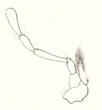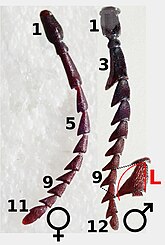Mesoprionus besikanus
| Mesoprionus besikanus | ||||||||||||
|---|---|---|---|---|---|---|---|---|---|---|---|---|

Mesoprionus besikanus |
||||||||||||
| Systematics | ||||||||||||
|
||||||||||||
| Scientific name | ||||||||||||
| Mesoprionus besikanus | ||||||||||||
| ( Fairmaire , 1855) |
Mesoprionus besikanus , often still Prionus besikanus called and falsely also besicanus instead besikanus written, is a beetle from the family of the longhorn beetle and the subfamily Prioninae . The genus Mesoprionus was listed as a subgenus of the genus Prionus until recently. The species of the genus Prionus , which isrepresented throughout Europe,is the sawhorse Prionus Prionus coriacus . This can Mesoprionus besikanus be easily confused. In addition to Prionus coriacus and Mesoprionus besikanus in southeastern Europe, Mesoprionus asiaticus can also be found in the far east of Europe.
Comment on the name
The beetle was first described by Fairmaire in 1855 under the name Prionus besikanus . The word part besikanus refers to the place where it was found. Fairmaire received the Beetle from the ship's doctor Vesco . He found the insect when the French and English Mediterranean fleets anchored in the Bay of Bésika (opposite the island of Tenedos , Turkey) to demonstrate the support of the Ottoman Empire towards Russia. (The conflict led to the Crimean War ). The genus Prionus (of give a wiki. Πρίων "prion, príonos" for "Saw", pronotum was are and probe highly sawn) 1887 by Yakovlev divided into four sub-genres (Jakowleff, Yakovlev). The subgenus Mesoprionus was placed after the subgenus Prionus and before the other two subgenus. This explains the name Mesoprionus (old Gr. Μέσο "meso" for "middle"). Prionus batelkai and Prionus tangerianus , both (Sláma 1956) are classified as synonyms for Mesoprionus besikanus .
In 1879 LW Schaufuss also described a beetle with the name Prionus besikanus , which, however, does not match our beetle.
Properties of the beetle

|
|
| Fig. 1: Top view | |

|

|
| Fig. 2: Lower jaw with jaw probe |
Fig. 3: Lower lip with lip probes according to Migneaux 1868 |
The robust beetle is 23 to 32 millimeters long, the females are on average larger than the males. It is described here mainly in contrast to the sawhorse ( Prionus coriarius ). The beetle is at most dull, noticeably less shiny than the sawhorse.
The head is bigger and coarser than the sawhorse. A longitudinal furrow runs over the head and a transverse furrow over the upper lip. The latter is deeper than the sawhorse and extends to the deflection of the feelers. The number of antennae is twelve in both sexes, while the females of the sawhorse have only eleven antennae (Fig. 4). The cross-section of the antenna links is much less round than that of a sawhorse, the links become flat towards the tip of the antenna. From the third feeler link onwards, the links are strongly toothed, the extensions that form the teeth protrude about 45 ° to the feeler axis and do not encompass the base of the following segment as is the case with the sawhorse. The outer antennae are longer than they are wide, and on the sawhorse they are wider than they are long (Fig. 4, details). The antennae cut out the eyes in a strongly kidney shape and are somewhat larger than those of the sawhorse. The mandibles have an inner tooth that is missing in a sawhorse. The structure of the lower jaw is shown in Fig. 2, Fig. 3 shows the lower lip with lip probe.
The densely dotted pronotum is narrower than that of the sawhorse. As with the sawhorse, it is pulled out into two large teeth on the side. Compared to the sawhorse (Fig. 5), the front tooth is more pointed, the middle one more protruding and less curved backwards. The rear angle is more pointed and protruding further than on the sawhorse.
The elytra are very scattered and weakly punctured and less wrinkled than in the sawhorse. They taper more towards the rear than on the sawhorse. They are rounded together. The seam angle ends in an inconspicuous tooth.
The underside of the chest section is less hairy than that of the sawhorse. The process of the abdomen, which extends forward between the rear hips, is narrow and triangular in the female, but slightly wider than in the female sawhorse. It is not broadly rounded in front as in other species of the genus. The abdomen protrudes only a little beyond the wing covers.
The tarsi of the hind legs are narrow, the lobes of the third phalanx are pointed, but in the sawhorse (Fig. 6) they are broadly bilobed. With the other legs, the tarsi are like with the sawhorse, their third limb more or less broadly bilobed.
biology
Almost nothing is known about the biology of the beetle. During a survey of the insect fauna in Turkey, the beetle was found in the hollows of old oaks at a height of 1,000 to 1,500 meters. From Bulgaria, the beetle has been reported in deciduous forests up to an altitude of 1300 meters. Finds in Crete come from the months of May and June. The larvae may develop in the roots of plane trees.
distribution
The beetle is restricted to the southeast within Europe. The northern limit of its distribution runs through Bosnia-Herzegovina , Serbia and Bulgaria . North of it, he was also reported in isolation from the Republic of Moldova . The southernmost point of the distribution area is on Crete . Outside of Europe, the species can be found in Turkey and Cyprus . A message from Sláma from North Africa was withdrawn by himself.
Individual evidence
- ↑ a b Mesoprionus besikanus , Mesoprionus asiaticus and Prionus coriarius from Fauna Europaea, accessed on January 28, 2019
- ↑ a b c Léon Fairmaire: Rectifications et descriptions d'espèces nouvelles de coléoptères de la Faune méditerranéenne in Annales de la Société Entomologique de France 3rd ser. Tome 3 Paris 1855 p. 318
- ↑ a b B. E. Jakowleff: Révision des espèces du genre Prionus de la Faune de la Russie in Horae Societatis Entomologicae Rossicae Volume XXI, Petropoli 1887 pp. 321 - 340 Key for Prionus and drawing Plate IX, Fig. 10 and 14
- ^ A b I. Löbl, A. Smetana (ed.): Catalog of Palaearctic Coleoptera Vol. 6 Chrysomeloidea Stenstrup 2010 p. 23 Explanation of besanicus in the Google book search
- ↑ : LW Schaufuss: Numquam otiosus - Zoologische Mittheilungen III. Volume, Oberblasewitz near Dresden, 1897 p. 471
- ↑ a b Jaquelin du Val, L. Fairmaire: Genera des coléoptères d'Europe . Paris 1868 mouthparts, plate 37, Figs. 167b and 167c
- ↑ : Aug. Lameere: Revision des Prionides 21. mémoire Prionines VII, in Annales de la Société entomologique de Belgique Volume 56, Bruxelles 1912 p. 185 p. 200 Synonyms for coriarius , p. 202 Prionus besicanus
- ^ Andreas Semenow: Coleoptera asiatica nova in Horae Societatis Entomologicae Rossicae Volume XXXIV, Petropoli 1900 p. 303 key p. 325 4, 5, 6, 7, 8
- ↑ Gianfranco Sama et al .: Preliminary report on a survey of the saproxylic beetle fauna living on old hollow oaks (Quercus spp.) And oak wood in Turkey (Coleoptera: Cerambycidae) In Munis Entomology @ Zoology 6 (2) June 2011, p 819-831 [1]
- ↑ Pierrepaola Rapuzzi, Georgi Tsvetkov Georgiev: Contribution to the Knowledge of Species Composition and Regional Distribution of Longhorn Beetles (Coleoptera: Cerambycidae) in Bulgaria , in: Acta Zoologica Bulgaria 59 (3) 2007, pp. 253-266 PDF
- ↑ Wolfgang Schedl: Overview of the species diversity of longhorn beetles on the Greek island of Crete (Coleoptera: Cerambycidae). In: Linz biological contributions. Volume 45, Issue 1, Linz July 31, 2013, pp. 621-641 ( PDF on ZOBODAT ).
- ↑ ML Danilevsky: Additions and corrections to the new Catalog of Palaearctic Cerambycidae (Coleoptera) edited by I. Löbl and A. Smetana 2010, Part II . In: Russian Entomological Journal , 2010 19 (4), pp. 313-324 ( pp. 2/314 ).



